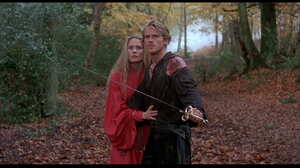The Princess Bride

As the 1980s drew to a close, Hollywood found itself at a crossroads, yet rather than choose a singular path, the industry embraced two seemingly contradictory cinematic impulses – hard-edged cynicism and open-hearted sincerity. Many of the era’s defining films stood out not only for their quality but also for the way they reflected these competing ideologies – some bleak, others warm, but all striking in their confident execution. The result was a fascinating blend of skepticism and sentimentality, a period where movies filled with brutal violence coexisted alongside works of lighthearted fantasy, offering a rich and varied experience for the moviegoer.
On one side, veteran filmmakers pushed storytelling to its most brutal, satirical, and nihilistic extremes. Stanley Kubrick’s Full Metal Jacket stripped war narratives of any lingering romanticism, presenting a harrowing vision of dehumanization and moral decay. Brian DePalma, known for his operatic excess, leaned into myth-making with The Untouchables, a stylized crime thriller that embraced grandeur without ever being mistaken for realism. Perhaps most audaciously, Paul Verhoeven twisted the sci-fi action film into an over-the-top, hyper-violent satire with Robocop, a ruthless indictment of corporate greed, consumerism, and the militarization of law enforcement. Each of these films challenged audiences with their stark worldviews and uncompromising presentations.
Meanwhile, independent filmmakers smuggled genuine pathos beneath layers of slapstick and absurdity. Sam Raimi’s Evil Dead 2 took the framework of his original film and amplified it to gleeful, manic extremes, blending horror and comedy with a singular energy. The Coen Brothers found humor and warmth in the absurdity of Raising Arizona, a screwball crime caper that injected unexpected honesty into a world of cartoonish criminals and surreal set pieces. John Hughes, best known for his coming-of-age comedies, delivered Planes, Trains, and Automobiles, a film that transcended its premise as a mismatched buddy comedy to reveal a rare emotional integrity beneath its surface.
Few films embody both sides of the era’s cinematic spectrum as perfectly, or balance its extremes as gracefully, as Rob Reiner’s The Princess Bride. On the surface, it appears to belong to the sincere camp: a fairy tale romance featuring dashing heroes, a beautiful princess, wicked aristocrats, and a grand quest for true love. Yet the film constantly undercuts its own frankness with sharp wit, sarcasm, and a self-awareness of how ridiculous its story should be, refusing to take any of its cinematic magic at face value. It believes in happily-ever-after but refuses to accept it without a knowing smirk.
Framed by a grandfather reading a book to his sick grandson, The Princess Bride cleverly comments on its own narrative mechanics while allowing for genuine emotional investment. The tale within the novel follows Westley, a humble farm boy turned legendary Dread Pirate Roberts, as he attempts to rescue his beloved Buttercup from an unwanted marriage to the scheming Prince Humperdinck. Along the way, he encounters a trio of unforgettable rogues: Indigo Montoya, a vengeful Spanish swordsman; Fezzik, a gentle but formidable giant; and Vizzini, a self-proclaimed genius undone by his own arrogance.
The Princess Bride operates on multiple levels – functioning as a straightforward fairy tale, an affectionate parody of the genre, and an adventure comedy driven by both slapstick and razor-sharp dialogue. William Goldman’s screenplay, adapted from his own novel, expertly balances mockery and admiration, acknowledging the cliches of the genre while embracing their timeless appeal with a wry twist. Rather than deconstructing the fairy tale, the film reinvigorates it, blending satire with an unwavering belief in heroism, justice, and true love. It is a direct love letter to the enduring power of storytelling, and the belief that anything is possible.
Upon its release in the fall of 1987, the film performed modestly at the box office – earning a respectable sum but not an instant phenomenon. However, like many cult classics, its afterlife proved far more significant than its initial reception. Home video allowed it to flourish, passed down by families through generations much like the grandfather’s story to his grandson. Today, The Princess Bride remains a cultural touchstone due to its refusal to be locked into any single genre classification – it is not merely a comedy, a romance, or an adventure film, but a unique hybrid that defies easy categorization.
Perhaps the greatest testament to its enduring legacy is its broad and ever-growing audience. Unlike other classic motion pictures that belong to a specific generation, The Princess Bride resonates with viewers at different stages of life. A child may delight in its adventure, a teenager in its humor, and an adult in its brilliant balancing act between satire and truth. Like the best fairy tales, it adapts to its audience rather than the other way around; its humor is universal, and its storytelling is timeless, ensuring its place in popular culture for generations to come.
The films of 1987 exemplify a fascinating duality – one where cinema embraced both excess and restraint, cynicism and sincerity. Kubrick’s cold detachment, DePalma’s stylized grandeur, and Verhoeven’s satirical brutality pushed genre boundaries with unflinching visions, while the mania of Evil Dead 2, whimsy of Raising Arizona, and warmth of Planes, Trains, and Automobiles found humanity in unexpected places. The Princess Bride, standing at the intersection of these two approaches, perfectly encapsulated the era’s willingness to take creative risks. Whether through subverting expectations or embracing earnestness without irony, the defining films of 1987 proved that Hollywood’s greatest strength lay in its ability to embrace contradiction.
And as a footnote, the same year also saw the release of Elaine May’s Ishtar, a satirical comedy starring Warren Beatty and Dustin Hoffman as hapless musicians entangled in Middle Eastern politics. A critical and commercial failure upon release, it followed the troubled production history of May’s earlier Mikey and Nicky, a darkly intimate crime film starring John Cassavetes and Peter Falk as small-time mobsters. Both films, dismissed in their time, have since been reappraised, reinforcing May’s unique narrative sensibilities, resilience in an unforgiving industry, and status as one of the most distinctive female directors of the New Hollywood era.
